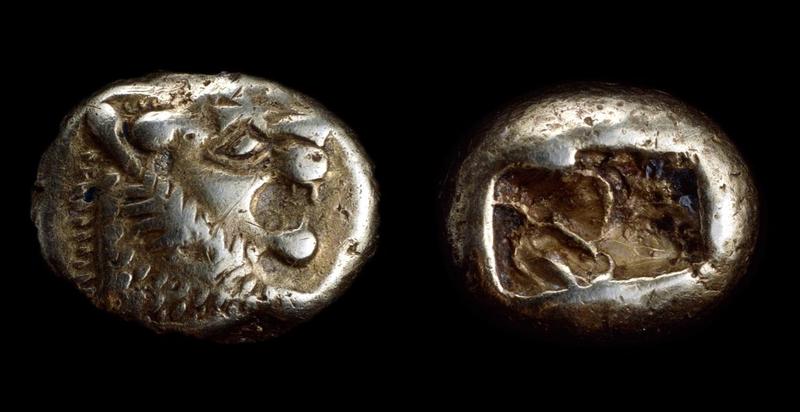Lydian Electrum
Dublin Core
Title
Lydian Electrum
Subject
Early Lydian Coinage
Description
Electrum 1/6 stater
Lydian, about 650-600 BC
From western modern Turkey
One of the very earliest coins
The Greek historian Herodotus, writing in the fifth century BCE, stated that 'the Lydians were the first people we know to have struck and used coinage of silver and gold.' He is almost correct. The earliest coins were in fact made from electrum, an alloy of gold and silver. But, based on the evidence of their findspots, we can be fairly confident that the first coins were issued in the area of Lydia, today in western Turkey. These coins had a design on one side only - a result of the primitive method of manufacture.
The coins were hand struck. A die with a design (in this case a lion's head) for the obverse (front) of the coin was placed on an anvil. A blank piece of metal was placed on top of the die, and a punch hammered onto the reverse. The result was a coin with an image on one side and a punch mark on the other.
The device of the lion on these coins has often led to the assumption that they were issued by a royal power, the kings of Lydia. In truth, we cannot say for certain who minted these earliest coins.
G.K. Jenkins, Ancient Greek coins (London, Seaby, 1990)
Lydian, about 650-600 BC
From western modern Turkey
One of the very earliest coins
The Greek historian Herodotus, writing in the fifth century BCE, stated that 'the Lydians were the first people we know to have struck and used coinage of silver and gold.' He is almost correct. The earliest coins were in fact made from electrum, an alloy of gold and silver. But, based on the evidence of their findspots, we can be fairly confident that the first coins were issued in the area of Lydia, today in western Turkey. These coins had a design on one side only - a result of the primitive method of manufacture.
The coins were hand struck. A die with a design (in this case a lion's head) for the obverse (front) of the coin was placed on an anvil. A blank piece of metal was placed on top of the die, and a punch hammered onto the reverse. The result was a coin with an image on one side and a punch mark on the other.
The device of the lion on these coins has often led to the assumption that they were issued by a royal power, the kings of Lydia. In truth, we cannot say for certain who minted these earliest coins.
G.K. Jenkins, Ancient Greek coins (London, Seaby, 1990)
Source
http://www.britishmuseum.org/explore/highlights/highlight_objects/cm/e/electrum_16_stater.aspx
Publisher
The British Museum, CM BMC Lydia 6
Date
650-600 BCE
Rights
© Trustees of the British Museum
Format
Weight: 2.560 g
Diameter: 10.000 mm
Diameter: 10.000 mm
Collection
Citation
“Lydian Electrum,” Hallie Ford Museum of Art Exhibits, accessed November 23, 2025, https://library.willamette.edu/hfma/omeka/items/show/14.
